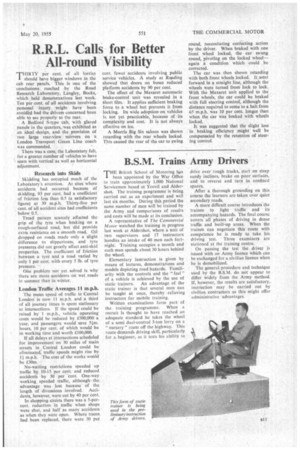R.R.L. Calls for Better All-round Visibility
Page 37

If you've noticed an error in this article please click here to report it so we can fix it.
THIRTY per cent, of all lorries
I should have bigger windows in the cab rear panels. This is one of the conclusions reached by the Road Research Laboratory, Langley, Bucks, which held demonstrations last week. Ten per cent, of all accidents involving personal injury might have been avoided had the drivers concerned been able to sec properly to the rear.
A Bedford S-type cab, with glazed panels in the quarters, was exhibited as an ideal design, and the provision of two large rear-view mirrors on a London Transport Green Line coach was commended.
There was a case, the Laboratory felt, for a greater number of vehicles to have seats with vertical as well as horizontal adjustment.
Research into Skids
Skidding has occupied much of the Laboratory's attention. At sites where accidents had occurred because of skidding, 93 per cent, had a coefficient of friction less than 0.5 (a satisfactory figure) at 30 m.p.h. Thirty-five per cent. of all accident sites had coefficients below 0.5.
Tread pattern scarcely affected the grip of the tyre when braking on a rough-surfaced road, but did provide extra resistance on a smooth road. Oil dropped on roads made only a slight difference to slipperiness, and tyre pressures did not greatly affect anti-skid properties. The coefficient of friction between a tyre and a road varied by only 1 per cent, with every 5 lb. of tyre pressure.
One problem not yet solved is why there are more accidents on wet roads in summer than in winter.
London Traffic Averages 11 m.p.h.
The mean speed of traffic in Central London' is now 11 m.p.h. and a third of all journey times is spent stationary at intersections. If the speed could be raised by 1 m.p.h., vehicle operating costs would be reduced by £500,000 a year, and passengers would save 51m. hours, 10 per cent. of which would be in working time and worth £100,000.
If all delays at intersections scheduled for improvement on 30 miles of main streets in Central London could be eliminated, traffic speeds might rise by II m.p.h. The cost of the works would be £30m.
No-waiting restrictions speeded up traffic by 10-15 per cent. and reduced accidents by 30 per cent. One-way working speeded traffic, although the advantage was lost because of the length of divessions involved. Accidents, however, were cut by 40 per cent.
In shopping streets there was a 5-percent. reduction in traffic when shops were shut, and half as many accidents as when they were open. Where trams had been replaced, there were 30 per cent, fewer accidents involving public service vehicles. A study at Reading showed that doors on buses reduced platform accidents by 90 per cent.
The effect of the Maxaret automatic brake-control unit was revealed in a short film. It applies sufficient braking force to a wheel but prevents it from locking. Its wide adoption on vehicles is not yet practicable, because of its complexity and cost. It is not always effective on ice.
A Morris Big Six saloon was shown retarding with the rear wheels locked. This caused the rear of the car to swing round, necessitating correcting action by the driver. When braked with one front wheel locked, the car swung round, pivoting on the locked wheel— again a condition which could be corrected.
The car was then shown retarding with both front wheels locked. It went forward in a straight line, although the wheels were turned from lock to lock. With the Maxaret unit applied to the front wheels, the car could be braked with full steering control, although the distance required to come to a halt from 65 m.p.h. was 10 per cent, longer than when the car was braked with wheels locked, It was suggested that the slight loss in braking efficiency might well be compensated by the retention of steering control.




















































































